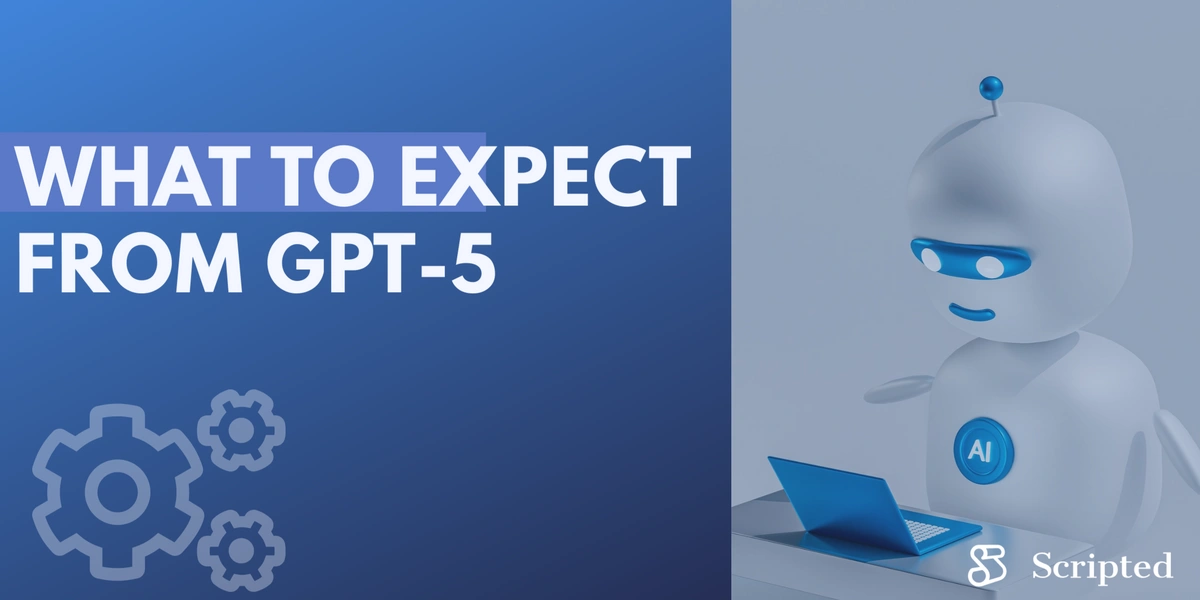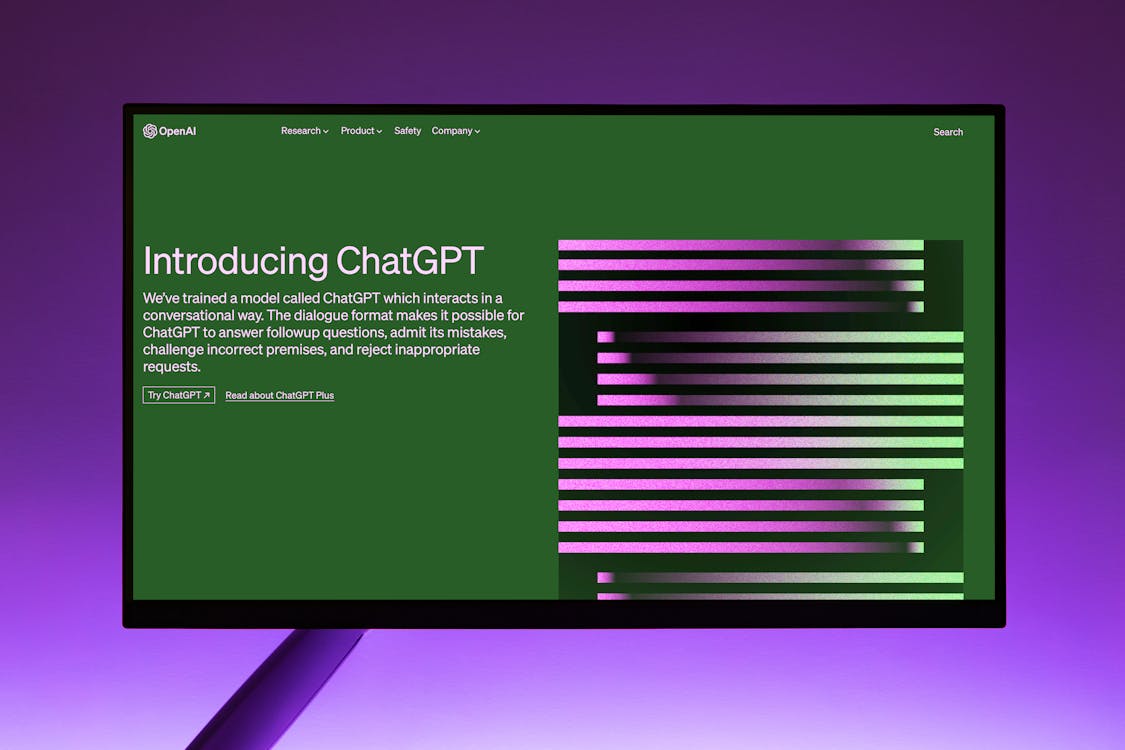- Blog Home
- Ai
- Scripted Writers
- What To Expect From Gpt 5
What to Expect from GPT-5

Artificial intelligence and machine learning experts OpenAI made waves in late 2022 with ChatGPT. Now GPT-4 has millions of users around the world, so the obvious question is, “What’s next?” The technological jump between GPT-3 and GPT-4 was phenomenal, so what can we expect from GPT-5?
A Brief History of the GPT Series
GPT stands for generative pre-trained transformer. This is an AI model trained on huge volumes of text, allowing it to fairly accurately predict what should come next when creating sentences based on prompts from users. This type of AI is called a large language model, or LLM. LLMs are a type of deep neural network that uses natural language processing (NLP) and natural language generation (NLG) to emulate human writing.
GPT-3
GPT-3 was created by OpenAI and launched in 2020. It was the follow-up to GPT-1 and -2 but was notable at the time for having a capacity ten times larger than the next biggest competitor, Turing NLG by Microsoft. GPT-3 was arguably the first instance of creating newspaper-type articles relatively indistinguishable from some human-crafted journalism.
OpenAI also openly discussed the possible risks of generative AI, a first within the AI development community.
GPT-3.5
With this last point in mind, GPT-3.5 focused on making AI models safer with more natural, human-like interaction. A key aspect of this is reinforcement learning from human preferences (RLHF), making human feedback absolutely essential to the successful development of this type of model.
ChatGPT

The need for larger volumes of human feedback led to the development of ChatGPT. ChatGPT is the AI application that’s rocked the world as we know it. This is primarily because OpenAI decided to launch ChatGPT publicly in November 2022, an ideal way to access a constant stream of data from users of all demographics.
ChatGPT broke records at the time, gaining 100 million users in just two months and becoming the fastest-growing app in history.
GPT-4
Hot on the heels of ChatGPT came GPT-4, an advancement OpenAI called “the latest milestone in…scaling up deep learning.” GPT-4 accepts images and text and outputs much more human-like responses.
GPT-4 is now OpenAI’s most capable AI model. Anyone thinking this is just a way to enhance chatbots or generate better-written content — think again. One of the organizations leveraging GPT-4 technology is Be My Eyes. They’ve created an app that becomes a virtual assistant for blind people or those with visual impairments. GPT-4 can tell someone what’s in their fridge, what they need from the grocery store, and even suggest a recipe. This is a great example of the life-improving potential of generative AI.
Features We Might See in GPT-5
The next natural step in this timeline is GPT-5, but with GPT-4 already showing substantial advancements, what can we expect from a new iteration?
More Factual Content
Generative AI is famously inaccurate. Incorrect responses range from wrong answers to math problems to reporting on earthquakes that never happened. These “fake facts” delivered with absolute confidence by AI tools are known as hallucinations. Expect vastly reduced hallucination rates in future GPT launches.
Reduced Costs and Increased Efficiency
The financial burden of integrating GPT-4 into business services is potentially high, costing businesses between 3 and 12 cents per thousand prompts. This might not sound like much, but if you run a global retail business handling thousands of chatbot messages a day, this adds up quickly. Increasing the efficiency of the computational power behind GPT products could reduce the costs for businesses. This, in turn, could increase the uptake of AI tools.
Multiple Input Types
GPT-3 and -3.5 dealt with text. GPT-4 can handle images. Imagine a generative AI with access to video content, music, speech, and even IoT sensors handling weather data like temperature. Increasing the types of data and input AI models can interpret could vastly increase the usefulness of these tools.
If generative AI does learn to respond to multiple inputs, that brings developers one step closer to artificial general intelligence — AI that closely resembles humans in the way it reacts to its surroundings.
GPT-5 Release: When Will GPT-5 Launch?
OpenAI CEO Sam Altman recently debunked a statement that GPT-5 would be trained by December. That means that, sadly, we have no release date at this time. We only know that there will definitely be more developments from the ambitious teams at OpenAI. There could be a GPT-4.5 in the interim or more focus on utilizing imagery as well as text. It’s also worth remembering that current models receive regular updates. For example, ChatGPT Plus users get access to new features as soon as they’re launched.
Challenges for GPT-5

As AI advances, it’s inevitable that conversations around ethics arise. There are already concerns about the training of AI using copyrighted materials. There have even been instances where AI companies used private, protected personal information to train a healthcare AI. The results could benefit everyone, but is that worth the loss of privacy? These are the types of questions and concerns that need addressing as companies like OpenAI produce more capable models.
Of course, ethics is a very human consideration. With careful guidance and strict rules, AI should be safe and useful, a tool to help us advance other areas of technology, such as transit, energy production, and fintech. If AI trainers work hard to reduce bias and ensure no protected data gets used in the development of AI, that will help answer questions posed by concerned users.
By the time GPT-5 launches, it will be essential that these worries are addressed directly. There have already been open letters appealing to AI companies to halt research and development on further models. While the concerns in these letters are largely unfounded, OpenAI could raise its profile and reassure users by dealing with negative media head-on.
Exploring AI in the Here and Now

If you can’t wait for GPT-5 to launch, don’t worry, there are plenty of exciting AI developments occurring right now. ChatGPT is still free to use, and the new ChatGPT Plus powered by GPT-4 is $20 a month for AI fans who want to stay up to date with all the latest features and upgrade releases.
Here at Scripted, we’re also delighted to announce that we’ve got our first AI-only content plan, and it’s completely free. Our new Starter plan allows users to access Scripted Copilot, our GPT-4 chatbot, and a host of content generation features, including social media post creation, headline generation, ad copy, and more. You can generate text for infographics or even craft a press release. Plus, you get access to Scripted’s world-class customer support.
We’ve believed in the power of AI to enhance human-written content for some time. Now we’re excited to add these state-of-the-art AI technologies to our platform alongside subject matter expert (SME) writers and other services such as SmartMatch.
AI efficiency and human creativity go hand in hand. As AI develops, it will help creatives and businesses increase their productivity while actually freeing up personnel to focus on the tasks they’re passionate about.
Find out more about AI and content generation: Get started with Scripted for free.